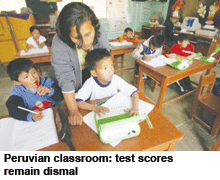Giving a child a computer does not seem to turn him or her into a future Bill Gates — indeed it does not accomplish anything in particular. That is the conclusion from Peru (pop.29 million), epicentre of the largest single programme involving One Laptop per Child, an American charity with backers from the computer industry and which is active in more than 30 developing countries worldwide.
 Peru is enjoying an economic boom, but has one of Latin America’s worst education systems. Flush with mining revenues, the previous government embraced the laptop initiative. It spent $225 million (Rs.1,147 crore) to supply and support 850,000 basic laptops to schools throughout the country. But Peruvians’ test scores remain dismal. Only 13 percent of seven-year-olds were at the required level in maths and only 30 percent in reading, the education ministry reported in March.
Peru is enjoying an economic boom, but has one of Latin America’s worst education systems. Flush with mining revenues, the previous government embraced the laptop initiative. It spent $225 million (Rs.1,147 crore) to supply and support 850,000 basic laptops to schools throughout the country. But Peruvians’ test scores remain dismal. Only 13 percent of seven-year-olds were at the required level in maths and only 30 percent in reading, the education ministry reported in March.
An evaluation of the laptop programme by the Inter-American Development Bank (IDB) found that even after working on computers, the children did not show any improvement in maths or reading. Nor did it find evidence that access to a laptop increased motivation, or time devoted to homework or reading. The report applauded the government for providing much-needed hardware: less than a quarter of Peruvian households owned a computer in 2010. “But it now needs to improve teacher-training and the curriculum,” says Julian Cristia of IDB. Above all, the classroom environment needs to change.
Part of the problem is that students learn faster than many of their teachers, according to Lily Miranda, who runs a computer lab in a state school in San Borja, a middle-class area of Lima. Sandro Marcone, who is in charge of educational technologies at the ministry, agrees. “If teachers are telling kids to turn on computers and copy what is being written on the blackboard, then we have invested in expensive notebooks,” says Marcone. It certainly looks like that.
(Excerpted and adapted from The Economist)